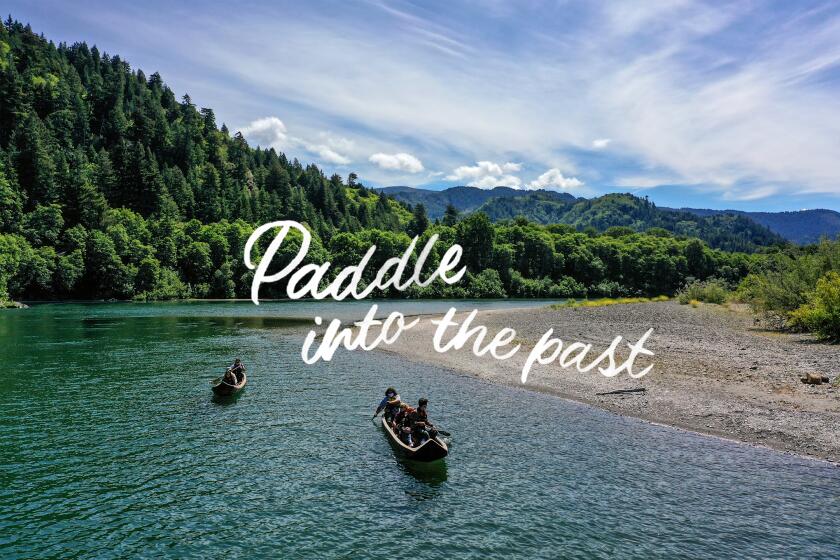A bucket list trip: Pedal through a Northern California forest on old railroad tracks
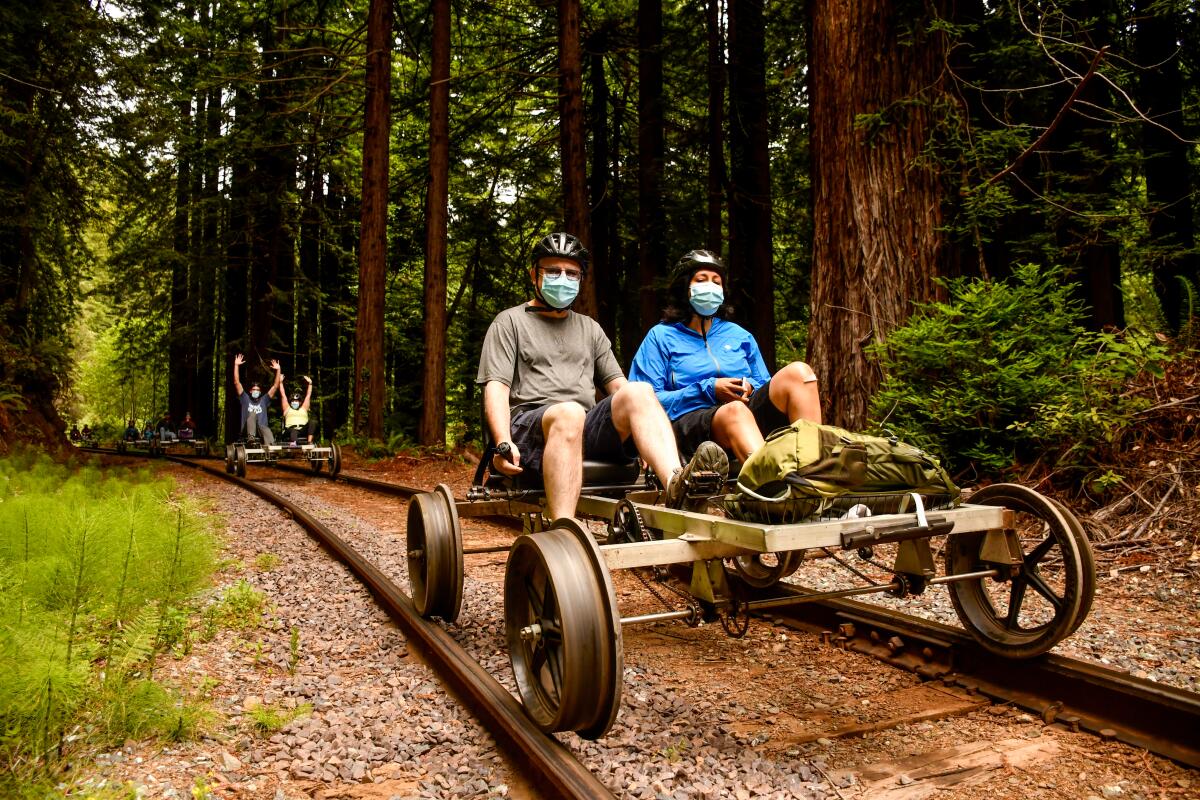
FORT BRAGG, Calif. — I’ve been playing on the railroad.
More specifically, I’ve been rolling along the forest path of the Skunk Train just outside Fort Bragg in Mendocino County. The tracks, laid by a 19th century logging company, are surrounded by towering redwoods, Douglas fir, alder and a carpet of ferns. The tourist train runs daily.
But I haven’t been riding the train.
I’ve been pedaling a railbike, a lightweight, four-wheeled, two-seat contraption with “pedal assist” like you’d find on an e-bike. Other versions of the same idea are known as railcycles and rail explorers. Across the U.S., these pedal-driven vehicles (some with pedal-assist, some without) are multiplying on idle or mostly idle railroad tracks, including some on the outskirts of Las Vegas, Sacramento and Carson City, Nev.
Recycling doesn’t get any more literal than this. And the trend makes for a fascinating recreational Venn diagram, bringing together railroad nerds, the rails-to-trails movement, cycling geeks and travelers who will climb on a bike if the pedaling is easy.
Moreover, these modified bikes arrived at a crucial moment for the Skunk Train, whose viability was threatened several years ago by a tunnel collapse and a landslide.
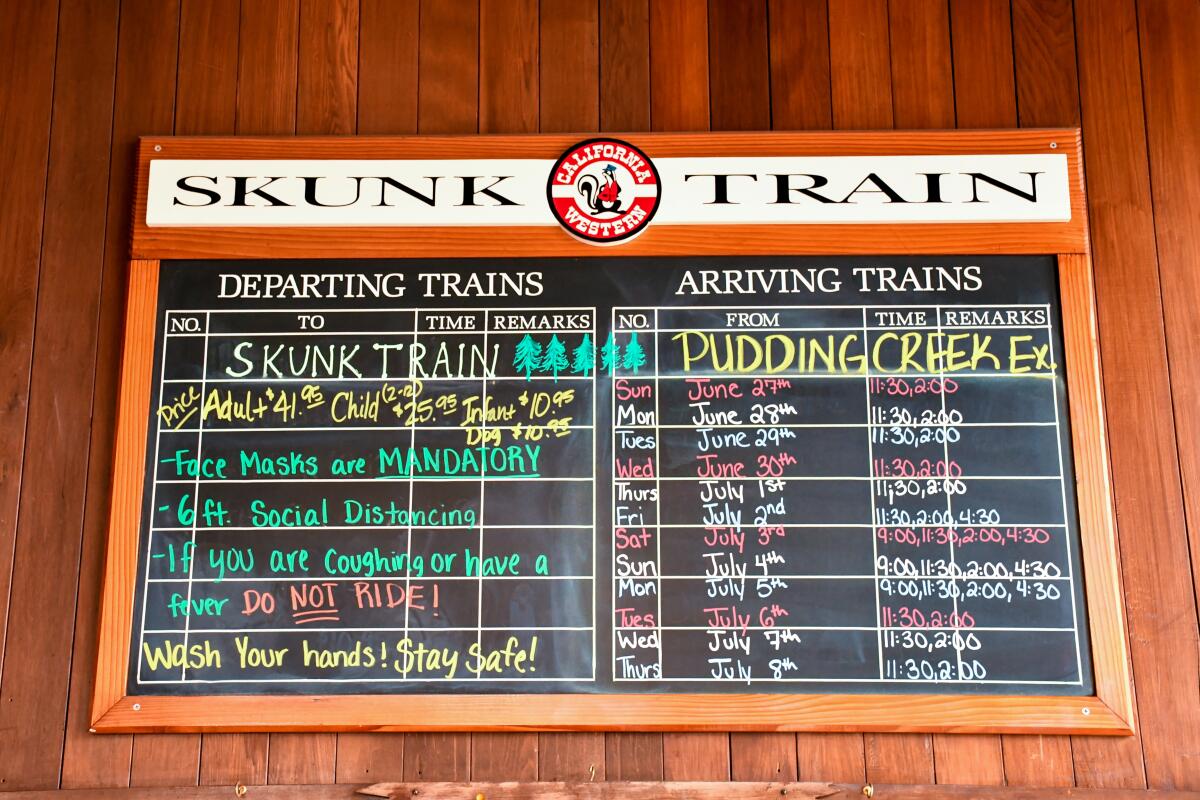
“We basically had to figure out how to make lemonade out of lemons,” said Robert Pinoli, who started offering railbike rides in 2018. Now the company runs as many as five excursions per day.
To pedal the rails at Fort Bragg, you book a trip, show up at the station, settle into a vehicle, don a helmet and seat belt, pedal through four downtown intersections (train signals halt traffic) and pass a cemetery.
Then suddenly you’re in the woods, hearing only birdsong and the gentle hum of wheels on tracks. There’s no need to exert yourself pedaling: The railbikes, which weigh about 250 pounds each, are outfitted like e-bikes with quiet electric motors that can push you along at 10 mph even if you don’t pedal.
You follow your guide for about 3½ miles, a stretch that includes three little bridges, until you reach Tunnel No. 1, now filled with rocks. Then you take a break for a short forest walk or snack. While you relax, two guides reverse the railbikes on a turntable so you can head back the way you came.
“It’s a twist on the past, not a lace-doily experience,” Pinoli said.
Just as wine put Napa and Sonoma counties on the map, farms in the region are attracting attention with tours, classes and tastings on cheese
At first glance, these trips are the ideal COVID-era pursuit, outdoors and distanced. But for now, riders must wear masks, because rail travel is regulated by the Federal Railroad Administration and Transportation Security Administration, which has mandated masks for passengers through at least Sept. 13.
Still, it can be a liberating trip — and there are surprises.
Because there’s no steering, your hands are free to shoot photos and video. To slow or stop, you squeeze the hand brakes (and use hand signals to alert those behind you). On a typical trip, the guide in front is followed by guests (usually in pairs) on as many as 12 bikes, followed by a second guide in back, with ample spacing between rigs.
Along the way, you’ll skirt Pudding Creek and perhaps glimpse osprey or blue heron. And when the blackberries and thimbleberries are ripe, “it’s not uncommon in the early hours to see a bear,” Pinoli said. “They generally scurry right along.” (Guides carry bear spray.)
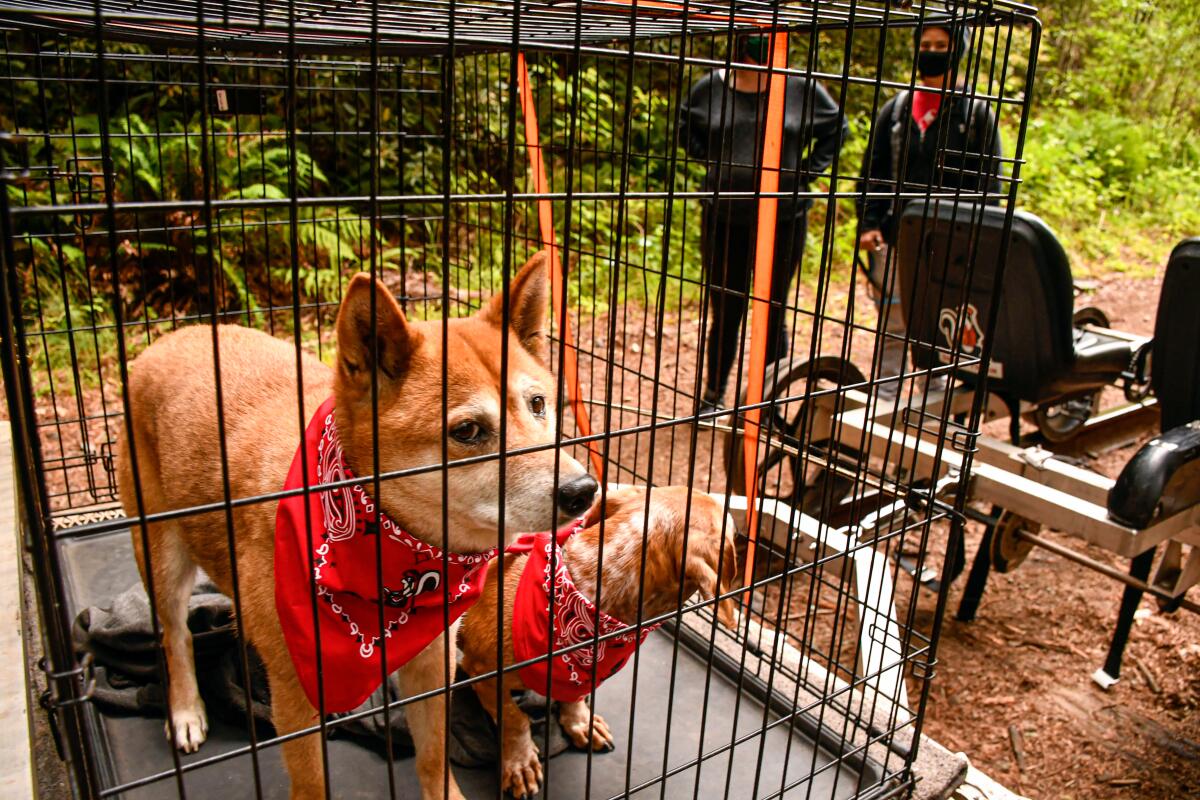
Most often, the redwoods are stars of the show. Guides will talk a bit about how long the trees live (up to thousands of years); how tall they get (more than 300 feet); how they survive fire and lightning strikes (remarkably well, usually); and how, in the early days of logging, families used to keep livestock in “goose pens” — the base of a redwood that was hollowed out by fire while the tree above remained tall and healthy.
“All of the larger trees of this area were logged out 100 years ago, so what you’re seeing today is the forest growing back,” guide Bruce Price told us.
Pedaling is “a different way to see the redwoods. And we learned more,” said Cindi Veverka, visiting from the Philadelphia suburbs with her daughter Cayla.
Rates are $250 per bike (whether single or double) for the two-hour ride, and children age 6 and older are allowed. (Drones are not.) For an added $30, the guides will put a dog trailer on the back of your rig. On just about every trip, guides say, there’s at least one dog.
Old idea, new enthusiasm
Pedaling on train tracks dates to the 19th century, when the bicycle was born and American railroad barons were racing to connect the East and West coasts. But the idea has gained momentum in the last several years, spreading from the East Coast to West and drawing on global influences from Korea, France and beyond.
In fact, Rail Explorers co-owner Mary Joy Lu, one of the movement’s pioneers in the U.S., has said she was inspired by a scene in a 2012 Korean soap opera.
These redwood canoes link past and future on the Klamath River. Here’s how my ride went.
Rail Explorers now runs bikes on several tracks in New York and Rhode Island and outside Las Vegas, where the company joined with the Nevada State Railroad Museum to offer several one-way pedaling tours, some by day, some by night, all flat or downhill journeys without motorized assistance.
Heather Abel, division manager for Rail Explorers Las Vegas, said in an email that the tours began as a seasonal offering in 2018, expanded to year-round trips in 2019 and have remained open throughout the pandemic. The most popular: the Southwest Summer Soaker, a four-mile, 90-minute journey that features a semi-surprise “attack” by Rail Explorers staff with Super Soaker water guns.
A less stinky ride
The Skunk Train’s story began in 1885, when local lumber barons needed to get downed trees from the forest to the coast for milling and shipping. They built the Fort Bragg Railroad, and by 1925, its route reached 40 miles inland to Willits and its nickname had been coined, inspired by the mingled stench of the rail cars’ pot-bellied stoves and gas-fueled engines.
Get inspired to get away.
Explore California, the West and beyond with the weekly Escapes newsletter.
You may occasionally receive promotional content from the Los Angeles Times.
Over time, the railway evolved into Fort Bragg’s leading tourist attraction, carrying passengers instead of lumber. But in 2013 and 2015, Tunnel No. 1 suffered a collapse, then a landslide. Nobody was hurt, but the incidents closed a 1,122-foot-long passage completed by Chinese workers in 1893, making the trip to Willits impossible.
Since then, the company has done its best with two short train rides, one at the Fort Bragg end of the tracks, the other at the Willits end. There are plans to repair and reopen the closed tunnel by the end of 2022.
But the railbikes are the hardware of the moment.
Pinoli, whose company manufacturers its bikes, estimates that the railbike tours now bring in 30% to 40% of the Skunk Train’s revenue. He is in talks with Ventura County transportation officials in hopes of operating a train and railbikes on the 32-mile Santa Paula line between Ventura and Piru.
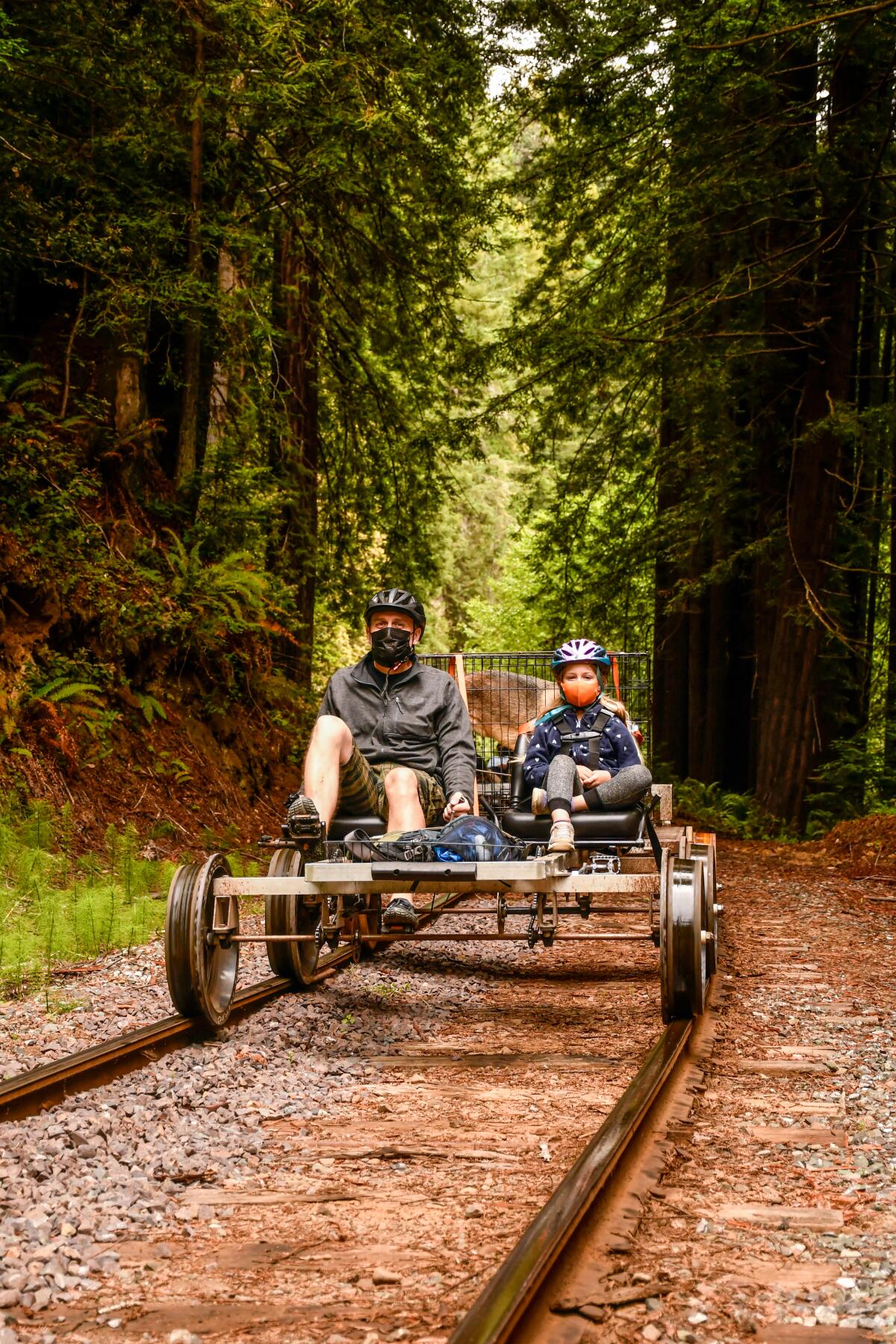
In a bid to win over more ambitious pedalers, the Skunk Train on July 16 introduced a longer ride outside Fort Bragg, a “strenuous and lengthy” 25-mile trip on a remote stretch of tracks beyond the closed tunnel.
That four-hour trip begins with a mile-long hike to the east end of Tunnel No. 1, then becomes a railbike journey following the twists and turns of the Noyo River, crossing 11 wooden trestle bridges, pausing for a riverside picnic lunch and then reversing direction. The price is $495 per two-person bike, lunch included, rain or shine (no pets on this trip).
“We were doing mock runs,” guide Bruce Price told me. “It’s beautiful here. But it’s 10 times nicer out there. The bridges are taller, with more water running under them. Everything is upscaled out there.”
If you go
Many visitors to Mendocino County fly into Santa Rosa’s Charles M. Schulz Sonoma County Airport, then rent a car and head north 112 miles to Fort Bragg. Alaska Airlines flies nonstop to Santa Rosa from LAX (from $69 one way), Hollywood-Burbank Airport (from $49 one way) and Orange County’s John Wayne Airport (from $99 one way). Avelo Airlines flies nonstop from Burbank from $69 one way, plus fees for seat assignments, carry-ons and baggage.
Riding the rails
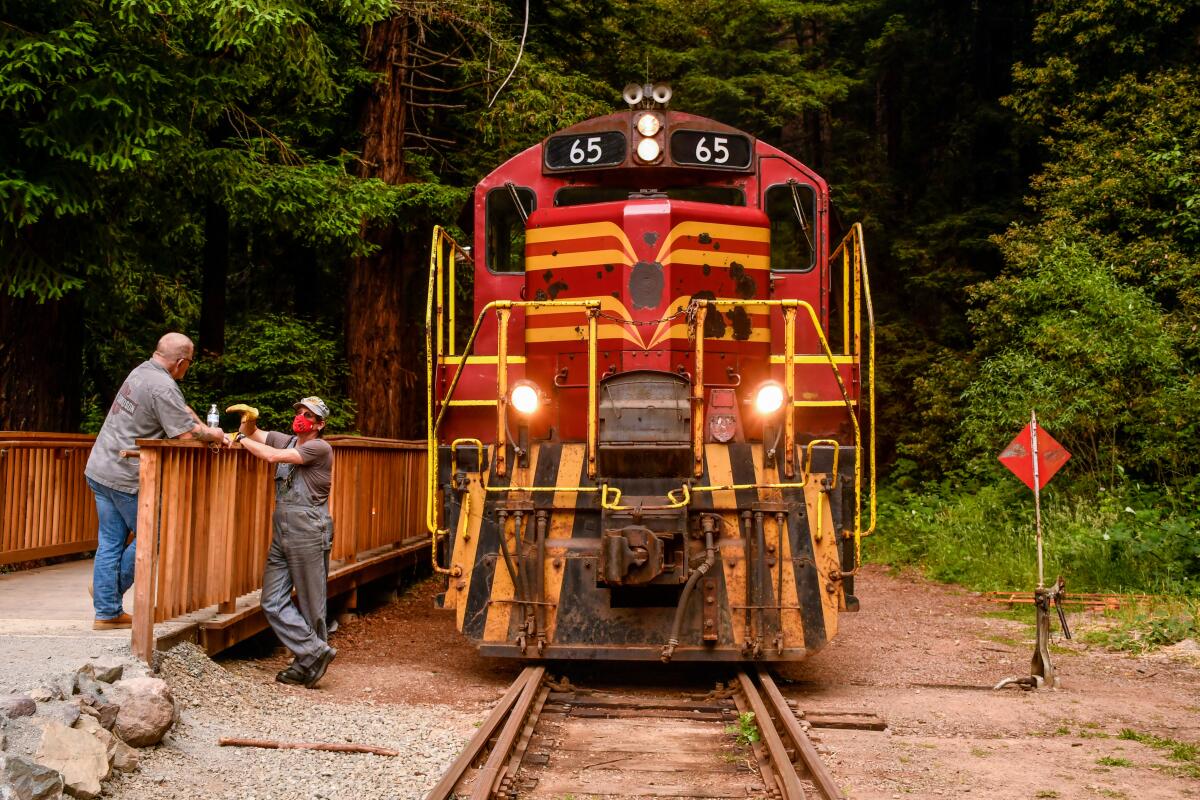
The Skunk Train, 100 W. Laurel St., Fort Bragg; (707) 964-6371. Offers short and long railbike trips. The shorter trips begin at the Fort Bragg depot; the longer trips begin near Tunnel No. 1, about four miles outside Fort Bragg. The company also offers traditional (and brief) round-trip train trips from Fort Bragg and Willits.
Where to eat
Three good dining options in Fort Bragg are the HarborView Bistro (open Wednesdays-Mondays for breakfast, lunch and dinner); the waterfront Noyo River Grill (open Fridays-Wednesdays for lunch and dinner); and the perennially busy Silver’s at the Wharf (lunch and dinner daily), also on the waterfront.
The best meal of my visit, however, was 10 miles south in Mendocino at the Fog Eater Cafe (open for dinner Wednesdays-Saturdays and brunch on Sundays), which serves Southern cuisine, all vegetarian. Another option if you’re driving through Anderson Valley on California 128: Boonville General Store, mostly organic, open daily for breakfast and lunch.
More to Read
Sign up for The Wild
We’ll help you find the best places to hike, bike and run, as well as the perfect silent spots for meditation and yoga.
You may occasionally receive promotional content from the Los Angeles Times.
